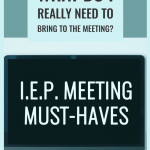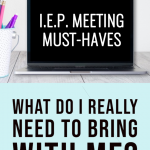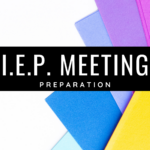
Maybe it's your first I.E.P. meeting at a new school (or ever!) or maybe you just have SO many papers and you're wondering…

Table of Contents
ToggleAs a proud attendee of literally hundreds of meetings, I've got this one!
My experience and advice is coming from my role as a special educator and now instructional coach supporting special education teachers. Please refer to your school district guidelines to make sure any specific guidelines and expectations are met.
Of course, you're going to bring DATA along with you to support any decisions that will be decided by the I.E.P. team. Even if you “just know” by good teaching instinct (and this is not sarcasm, teacher instinct is usually spot on), you'll need evidence to back it up.
This data includes documentation of what is working (or not). However, you don't want to arrive with data just for the sake of having it.
I've noticed that some forms of data speak louder than others.
Data with NUMBERS – Anecdotal notes and observations are extremely helpful, but numbers cut to the chase. At the I.E.P. table, I'll bring a summary page with the numbers (i.e.: frequency tallies, percentages) and save the anecdotal notes for my files.
Why did I make this my Number 1 recommendation? I find that numbers can be communicated with less confusion. Here's an example:

The above example stresses how both types of data are important. The anecdotal notes help us determine what part of the math lesson may be impacting Jen's behavior (i.e.: struggling with carpet time, or time that is less structured). However, those numbers – especially color-coded – leave no room for misunderstanding. Jen is potentially missing 74% of her math instruction.
Work Samples! A variety of work samples can speak VOLUMES about what is happening in the education setting. It can communicate work habits, level of independence, fine motor development, understanding of content, and so much more.
Displaying work samples can also help provide clarity of what's going well in the classroom. You may compare two pieces of work to demonstrate how well accommodations are working for the child. I've also had many meetings where a family member is surprised at how WELL their child is doing!
Gathering work samples doesn't necessarily have to be an extra chore if you implement a system from the beginning (or starting right now!).
I always displayed student work in my resource room. Each student on my caseload had a designated “spot.”
I didn't actually change out their work every week though, but instead simply “topped off” their work by adding the most recent page in the front. Think of it as layers – every week the new page is added, so there's a stack of five pages after five weeks. I found using a clothesline with clothespins worked better than thumbtacks for this:

Meeting time? Simply grab the stack off the bulletin board display. It's even in reverse chronological order to show improvement!
If displaying student work isn't appropriate, keeping a simple portfolio folder works well, too.
In summary, there's much MORE you can bring to an I.E.P. meeting to support the important decisions you are making to support each child's education. I have found that of all the different pieces of documentation we gather, numbers-based data and student work samples were the most effective.
I highly recommend checking out:
Inside the huge bundle, you'll find more support materials, including I.E.P. Meeting Agendas and Checklists, Writing I.E.P. Present Levels, Student-Led I.E.P. Meeting Kit, and so much more.

You're ready for your next I.E.P. Meeting – I can't wait to hear how it goes!

I’m Jennifer and I was a special educator in the elementary school setting over the past decade. I entered the classroom every day dedicated to making learning inclusive AND engaging.



















This website uses cookies to ensure you get the best experience on our website. See full disclosure here.
This website uses cookies to ensure you get the best experience on our website.
See full disclosure here.